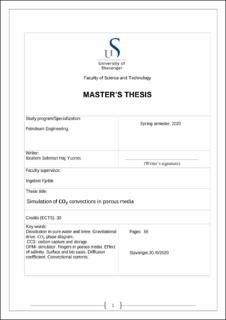| dc.description.abstract | Global warming is one of the challenges the world faces in the modern era. Therefore, the injection of carbon dioxide into the geological layers is one of the methods which have been used to reduce the emissions of carbon dioxide.
Carbon dioxide is injected into the oil layers for enhanced oil recovery (EOR), or in the aquifers for carbon storage. When carbon dioxide is injected in water phase, water carbonate will be formed. 𝐂𝐎𝟐 dissolution initiates by the diffusion, leading to an increase in the density of water. Thus, density-driven convective flow will occur which accelerate the carbon dioxide dissolution in water.
The purpose of this master thesis has been to simulate 𝐂𝐎𝟐 convections in porous media and studying the effect of some important parameters on 𝐂𝐎𝟐 dissolution by using an open porous media flow reservoir simulator which is called (OPM). Simulation will include the impact of salinity on the dissolution of carbon dioxide by varying the concentration of NaCl in water. In addition, illustrating the effect of changing the diffusion coefficient on the dissolution of carbon dioxide and permeability as well, studying the rate of 𝐂𝐎𝟐 dissolution in porous media with absence of pure water and comparing the results with the results of real experiment which has been done at same conditions and studying the effect of permeability heterogeneity on solubility of carbon dioxide.
This master thesis is consisting of three main parts. The first part is literature study, in this part will be focused on the basic theories and fundamentals for dissolution of carbon dioxide, important physical parameters which have impact on 𝐂𝐎𝟐 dissolution and overview about carbon capture and storage (CCS). The Second part is the simulating part, here OPMsimulator will be used to illustrate and discuss the effect of changing some important parameters on 𝐂𝐎𝟐 dissolution in two different cases. The first case is Case1, in this case the pressure will be 100 bars and temperature will be 50 Celsius. The second case is Case2, in this case pressure will be 10 bars and temperature 20 Celsius (room temperature). The third part will show some limitations of using the OPM-simulator, further work as continuation of this master thesis and some personal suggestions to improve the OPM-simulator.
Further steps can be done with OPM-simulator as kind of continuation are: studying the effect of heterogeneity with more specific details like adding different horizontal and vertical layers to see how it will affect on the dissolution of carbon dioxide. Extend the simulation to involve the dissolution of carbon dioxide in oil phase. The effect of minerals which can be founded in porous media the dissolution of carbon dioxide. | en_US |
